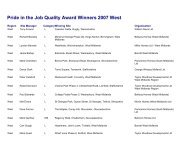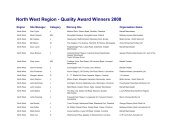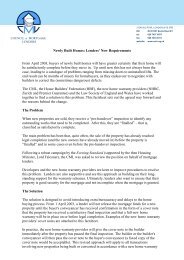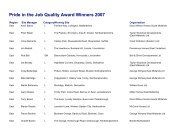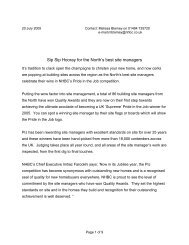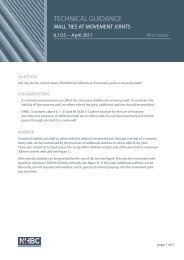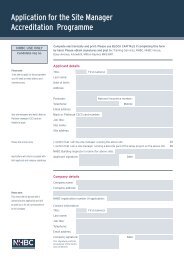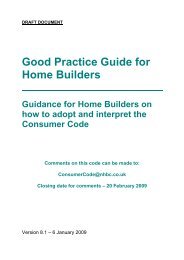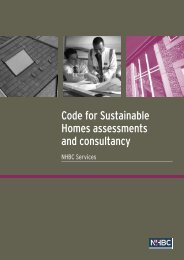Standards Extra - NHBC Home
Standards Extra - NHBC Home
Standards Extra - NHBC Home
You also want an ePaper? Increase the reach of your titles
YUMPU automatically turns print PDFs into web optimized ePapers that Google loves.
<strong>NHBC</strong> Foundation<br />
The <strong>NHBC</strong> Foundation’s latest reports cover<br />
two important topics – the management of<br />
construction site waste, and systemic failure in<br />
house building.<br />
‘Site waste management’ NF8<br />
The management of onsite waste is becoming increasingly important to the<br />
house-building industry. Not only is there a requirement to comply with<br />
environmental legislation (including The Site Waste Management Plans<br />
Regulations, which came into force in April 2008), but also to achieve cost<br />
savings by implementing good environmental practice.<br />
The construction industry uses an estimated 400 million tonnes of resources<br />
every year with 100 million tonnes ending up as waste. Construction projects<br />
involving multiple contractors can lead to confusion about who is responsible<br />
for environmental issues with implications for management of waste and<br />
disposal, licensing and permits, and working out who is responsible when<br />
things go wrong.<br />
In order to simplify the management of site waste, the <strong>NHBC</strong> Foundation and<br />
the Waste and Resources Action Programme (WRAP) funded research carried<br />
out by BRE to help the house-building industry write and implement site waste<br />
management plans (SWMPs) and recognise the associated benefits of putting<br />
these plans into practice.<br />
This guide provides the findings of this research as well as information on<br />
how waste created during the construction process can be managed more<br />
effectively as a result of writing and implementing a SWMP. It also provides a<br />
series of useful templates and checklists.<br />
‘Learning the lessons from systemic building failures’ NF10<br />
Throughout recent centuries there has been a gradual evolution of<br />
house-building practice and a continuous cycle of innovation. From time<br />
to time this innovation has inevitably given rise to unforeseen problems.<br />
Solutions have been found for these problems, lessons have been learnt<br />
and the industry has moved on.<br />
In parallel with the continuous innovation, there has been continuous<br />
refinement of building regulations, and our overall knowledge of what<br />
constitutes good practice has also developed.<br />
With innovative construction systems and materials, new detailing has to<br />
be developed that allows the particular design to be built. In many cases<br />
this leads to inadequate solutions, such as a reliance on sealants where,<br />
for example, a properly detailed flashing might be more appropriate.<br />
Although our overall knowledge has increased, it seems that our ability to<br />
pass that knowledge on to successive generations of professionals has<br />
diminished. This report reviews some historic problems for the benefit of<br />
today’s generation of professionals. It focuses on a number of systemic<br />
building failures that have come to light in various countries over the past<br />
30 years, including:<br />
failure of pre-cast reinforced concrete (PRC) houses in the UK<br />
moisture penetration of external insulation finish systems (EIFS) in<br />
British Columbia, Canada, the United States and New Zealand<br />
failure of structural insulated panel (SIP) roof systems in Alaska, USA.<br />
Site waste management report<br />
Systemic failure in<br />
house building report<br />
ACTION<br />
All <strong>NHBC</strong> Foundation<br />
reports can be downloaded<br />
at www.<strong>NHBC</strong>Foundation.org<br />
(click on ‘Projects’ tab to<br />
view all reports).<br />
3



